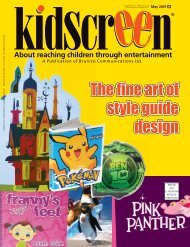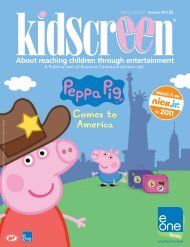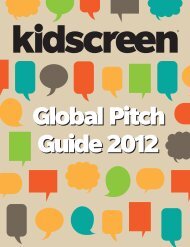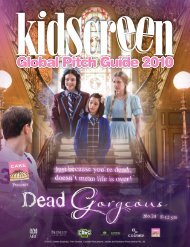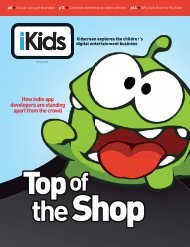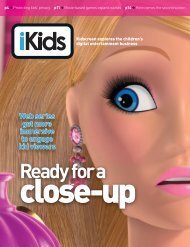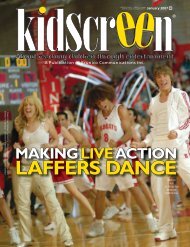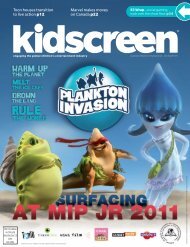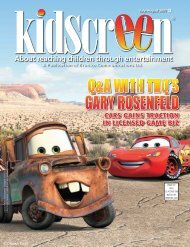rs ANIMATION SECIVRES CONTENTS - Kidscreen
rs ANIMATION SECIVRES CONTENTS - Kidscreen
rs ANIMATION SECIVRES CONTENTS - Kidscreen
You also want an ePaper? Increase the reach of your titles
YUMPU automatically turns print PDFs into web optimized ePapers that Google loves.
However, with glasses-free television sets still a few yea<strong>rs</strong><br />
away and the cost of animating in 3D still about 20% to 30%<br />
higher than CGI, the momentum to produce original stereoscopic<br />
kids content is maintaining a slow and steady pace. In<br />
fact, SD is one of many studios seeing the potential in producing<br />
3D to emerge fi <strong>rs</strong>t on smaller screens such as mobile devices,<br />
tablets and gaming consoles.<br />
“The biggest breakthrough, and the most exciting part for<br />
the kids production community, is what’s happening on smaller<br />
screens,” says Martell. She adds that it changes the experience<br />
entirely. Now, it’s no longer just event viewing.<br />
This fall, the company acquired Curtis Publishing, which<br />
owns iconic US publication Saturday Evening Post and children’s<br />
magazine titles Humpty Dumpty, Jack and Jill and Turtle. “We<br />
like working with properties that exist as brands, but don’t necessarily<br />
have stories or a linear entertainment piece,” she notes.<br />
So SD will be diving into those archives and creating short-, medium-<br />
and long-form stereoscopic content suitable for handheld<br />
devices.<br />
“You can’t put all your fi nancing together based on thinking<br />
you’re going to sell to television. You have to build your model<br />
and make your money back on what exists, knowing that 3D is<br />
the longtail upside,” says Martell.<br />
FUTURE-PROOFING<br />
Tiny Island CEO David Kwok also has his sights set beyond<br />
TV for the company’s properties, including Dream Defende<strong>rs</strong>,<br />
which had a budget of US$5.2 million and was partly funded<br />
by Singaporean government org MDA. A spin-off of the series is<br />
also available in the US for download on Nintendo’s 3D website,<br />
and Kwok is looking into developing content for 3D phones,<br />
tablets and goggles that will offer an imme<strong>rs</strong>ive experience.<br />
“I am not saying that we stop<br />
producing shows for the current<br />
traditional platform. I am saying<br />
that we need to plan ahead to<br />
future-proof content,” says Kwok.<br />
“Before we start producing any<br />
shows, we need to work out a plan<br />
to ensure the content that we produce<br />
can continue to tap these<br />
new platforms for the next fi ve<br />
yea<strong>rs</strong> to maximize our revenue.”<br />
To do that, Tiny Island designs<br />
content for traditional television,<br />
and stereoscopic and future autosterescopic<br />
3D platforms. And besides<br />
downloading Dream Defende<strong>rs</strong><br />
to watch on the glasses-free<br />
Nintendo 3D player, the prodco<br />
worked on a 3D eBook and struck<br />
a deal with Touch Music Publishing<br />
for a music video.<br />
Bolts and Blip’s ToonBox has<br />
amped up its 3D production capabilities,<br />
growing from a 2,500-square-foot studio with 30<br />
staff to a 12,000-square-foot space with 150 employees to<br />
take on its 3D feature fi lm Nut Job and 3D inte<strong>rs</strong>titial series<br />
The Beet Party. Chapman says the latter has been picked up<br />
by consumer electronics giant LG, which will preload the series<br />
onto its smart devices.<br />
“When The Beet Party launches on these devices, you’ll get<br />
a sense of the appetite because it will be available on a download-to-own<br />
basis, much like iTunes,” says Chapman. “You’ll be<br />
able to get analytics of how many people are downloading and<br />
watching those stereoscopic shorts.”<br />
WORKING WITH DIMENSION<br />
“As a producer, you have the technical information on one end<br />
that you have to be educated in, but you also have the creative<br />
information as well. It’s not just the script, it’s a new way of storytelling.<br />
It’s sculpting ve<strong>rs</strong>us painting,” says Alexander Lentjes,<br />
a stereographic consultant for Bristol, UK-based 3-D Revolution<br />
Productions.<br />
Why sculpting? Because, Lentjes explains, producing in three<br />
dimensions involves taking depth, volume and placement into<br />
consideration. It means guiding the eye through the space of the<br />
frame in a set direction, rather than reading an image from left to<br />
right. Ideally an original script will be penned with 3D pacing and<br />
elements in mind, but storyboarding really requires having a stereographer<br />
on-board to optimize the use of 3D.<br />
Kwok at Tiny Island also has expertise in making the most of<br />
3D stereoscopic. He says 3D effects are often used for establishing<br />
shots to give the audience a stronger feel of the space and<br />
depth of an environment. “Occasionally we have objects fl ying<br />
out from the screen to create a certain form of sudden excitement<br />
for the audience. However, we use it with care and don’t<br />
3D<br />
STEREOSCOPIC<br />
KIDSCREEN’S <strong>ANIMATION</strong> SERVICES ISSUE 2012<br />
11








